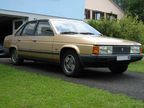Year of Talbot Tagora
Talbot Tagora photos, specs - Car Pictures & Images
 The Talbot Tagora is an executive car developed by Chrysler Europe and produced by Peugeot Société Anonyme (PSA). The Tagora was marketed under the Talbot marque after PSA took over Chrysler's European operations in 1979. PSA presented the first production vehicle in 1980 and launched it commercially in 1981. The Tagora fell far short of sales expectations, and PSA cancelled the model only two years later. Fewer than 20,000 Tagoras were ever built, all of them at the former Simca factory in the Poissy commune near Paris, France. |
Chrysler Europe began the development of the Tagora in 1976, under the code name C9, with the goal of replacing the unsuccessful Chrysler 180 series. Following the same development pattern as with the Horizon and Alpine models, the responsibility for the Tagora's technical development remained in France, while the styling was devised at Chrysler's design centre in the United Kingdom. An early proposal for the name of the car was "Simca 2000". DesignThe original C9 prototype was a modern-styled saloon with a low beltline, ample glazing and a generous interior made possible by the rather large wheelbase. The British design team initially proposed some stylistic features inspired by the Citroën SM, including a front glass panel between the headlights to accommodate the license plate, round front wheelarches and rear fender skirts. However, Chrysler management in the United States deemed these features too extravagant, so the design of the C9 became more conventional: front and rear wheelarches were squared off and the skirts lost, and the license plate was placed on the front bumper as on most cars. To better balance the rather tall silhouette, the beltline was raised. Over the course of development, the C9 also lost its vertical taillights in favour of more "fashionable" horizontal ones. Engine dilemmaThe main competitors in the executive vehicle market offered engines bigger than the biggest two-litre straight-4 used by Chrysler Europe, and a six-cylinder engine was generally expected. Consequently, the company had to seek a new engine for the Tagora. One candidate was the Mitsubishi straight-6, but it proved unsuitable for a car of this class. The other proposal was the Douvrin V6 engine (the "PRV"), a joint development of PSA, Renault and Volvo. Since the Tagora would be in direct competition with PSA models that used the PRV, it seemed unlikely that Chrysler would be able to procure that engine. Sales projectionsChrysler Corporation approved the development of the model on the assumption that Chrysler Europe would sell 60,000 C9s per year, which translated into a projected 5 percent share of the executive car market. This estimate seemed achievable because Chrysler had a 7 percent market share in Europe overall. The projected sales would have covered the car's tooling costs, with the development costs accounted for separately, as part of an independent annual budget. » Read More About Talbot Tagora |
